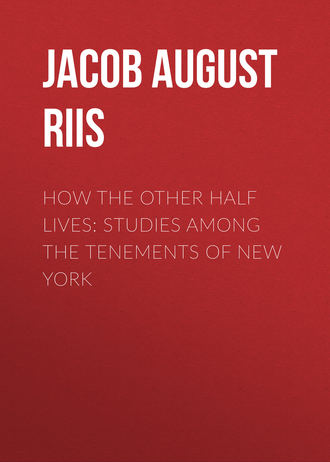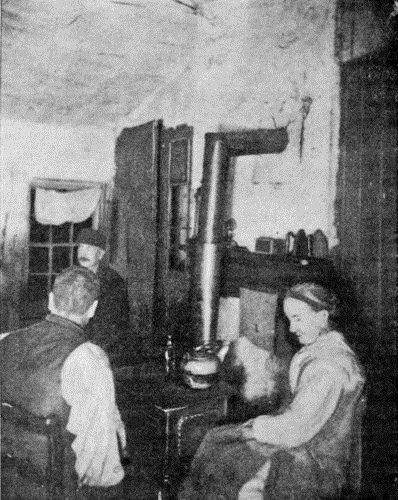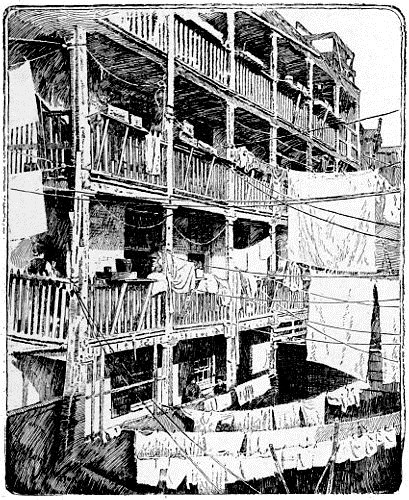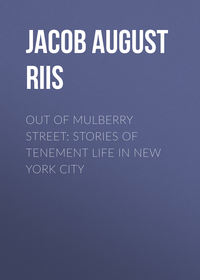 полная версия
полная версияHow the Other Half Lives: Studies Among the Tenements of New York

UPSTAIRS IN BLINDMAN’S ALLEY.
From their perch up among the rafters Mrs. Gallagher’s blind boarders might hear, did they listen, the tramp of the policeman always on duty in Gotham Court, half a stone’s throw away. His beat, though it takes in but a small portion of a single block, is quite as lively as most larger patrol rounds. A double row of five-story tenements, back to back under a common roof, extending back from the street two hundred and thirty-four feet, with barred openings in the dividing wall, so that the tenants may see but cannot get at each other from the stairs, makes the “court.” Alleys—one wider by a couple of feet than the other, whence the distinction Single and Double Alley—skirt the barracks on either side. Such, briefly, is the tenement that has challenged public attention more than any other in the whole city and tested the power of sanitary law and rule for forty years. The name of the pile is not down in the City Directory, but in the public records it holds an unenviable place. It was here the mortality rose during the last great cholera epidemic to the unprecedented rate of 195 in 1,000 inhabitants. In its worst days a full thousand could not be packed into the court, though the number did probably not fall far short of it. Even now, under the management of men of conscience, and an agent, a King’s Daughter, whose practical energy, kindliness and good sense have done much to redeem its foul reputation, the swarms it shelters would make more than one fair-sized country village. The mixed character of the population, by this time about equally divided between the Celtic and the Italian stock, accounts for the iron bars and the policeman. It was an eminently Irish suggestion that the latter was to be credited to the presence of two German families in the court, who “made trouble all the time.” A Chinaman whom I questioned as he hurried past the iron gate of the alley, put the matter in a different light. “Lem Ilish velly bad,” he said. Gotham Court has been the entering wedge for the Italian element, who until recently had not attained a foothold in the Fourth Ward, but are now trailing across Chatham Street from their stronghold in “the Bend” in ever increasing numbers, seeking, according to their wont, the lowest level.
It is curious to find that this notorious block, whose name was so long synonymous with all that was desperately bad, was originally built (in 1851) by a benevolent Quaker for the express purpose of rescuing the poor people from the dreadful rookeries they were then living in. How long it continued a model tenement is not on record. It could not have been very long, for already in 1862, ten years after it was finished, a sanitary official counted 146 cases of sickness in the court, including “all kinds of infectious disease,” from small-pox down, and reported that of 138 children born in it in less than three years 61 had died, mostly before they were one year old. Seven years later the inspector of the district reported to the Board of Health that “nearly ten per cent. of the population is sent to the public hospitals each year.” When the alley was finally taken in hand by the authorities, and, as a first step toward its reclamation, the entire population was driven out by the police, experience dictated, as one of the first improvements to be made, the putting in of a kind of sewer-grating, so constructed, as the official report patiently puts it, “as to prevent the ingress of persons disposed to make a hiding-place” of the sewer and the cellars into which they opened. The fact was that the big vaulted sewers had long been a runway for thieves—the Swamp Angels—who through them easily escaped when chased by the police, as well as a storehouse for their plunder. The sewers are there to-day; in fact the two alleys are nothing but the roofs of these enormous tunnels in which a man may walk upright the full distance of the block and into the Cherry Street sewer—if he likes the fun and is not afraid of rats. Could their grimy walls speak, the big canals might tell many a startling tale. But they are silent enough, and so are most of those whose secrets they might betray. The flood-gates connecting with the Cherry Street main are closed now, except when the water is drained off. Then there were no gates, and it is on record that the sewers were chosen as a short cut habitually by residents of the court whose business lay on the line of them, near a manhole, perhaps, in Cherry Street, or at the river mouth of the big pipe when it was clear at low tide. “Me Jimmy,” said one wrinkled old dame, who looked in while we were nosing about under Double Alley, “he used to go to his work along down Cherry Street that way every morning and come back at night.” The associations must have been congenial. Probably “Jimmy” himself fitted into the landscape.
Half-way back from the street in this latter alley is a tenement, facing the main building, on the west side of the way, that was not originally part of the court proper. It stands there a curious monument to a Quaker’s revenge, a living illustration of the power of hate to perpetuate its bitter fruit beyond the grave. The lot upon which it is built was the property of John Wood, brother of Silas, the builder of Gotham Court. He sold the Cherry Street front to a man who built upon it a tenement with entrance only from the street. Mr. Wood afterward quarrelled about the partition line with his neighbor, Alderman Mullins, who had put up a long tenement barrack on his lot after the style of the Court, and the Alderman knocked him down. Tradition records that the Quaker picked himself up with the quiet remark, “I will pay thee for that, friend Alderman,” and went his way. His manner of paying was to put up the big building in the rear of 34 Cherry Street with an immense blank wall right in front of the windows of Alderman Mullins’s tenements, shutting out effectually light and air from them. But as he had no access to the street from his building for many years it could not be let or used for anything, and remained vacant until it passed under the management of the Gotham Court property. Mullins’s Court is there yet, and so is the Quaker’s vengeful wall that has cursed the lives of thousands of innocent people since. At its farther end the alley between the two that begins inside the Cherry Street tenement, six or seven feet wide, narrows down to less than two feet. It is barely possible to squeeze through; but few care to do it, for the rift leads to the jail of the Oak Street police station, and therefore is not popular with the growing youth of the district.
There is crape on the door of the Alderman’s court as we pass out, and upstairs in one of the tenements preparations are making for a wake. A man lies dead in the hospital who was cut to pieces in a “can racket” in the alley on Sunday. The sway of the excise law is not extended to these back alleys. It would matter little if it were. There are secret by-ways, and some it is not held worth while to keep secret, along which the “growler” wanders at all hours and all seasons unmolested. It climbed the stairs so long and so often that day that murder resulted. It is nothing unusual on Cherry Street, nothing to “make a fuss” about. Not a week before, two or three blocks up the street, the police felt called upon to interfere in one of these can rackets at two o’clock in the morning, to secure peace for the neighborhood. The interference took the form of a general fusillade, during which one of the disturbers fell off the roof and was killed. There was the usual wake and nothing more was heard of it. What, indeed, was there to say?
The “Rock of Ages” is the name over the door of a low saloon that blocks the entrance to another alley, if possible more forlorn and dreary than the rest, as we pass out of the Alderman’s court. It sounds like a jeer from the days, happily past, when the “wickedest man in New York” lived around the corner a little way and boasted of his title. One cannot take many steps in Cherry Street without encountering some relic of past or present prominence in the ways of crime, scarce one that does not turn up specimen bricks of the coming thief. The Cherry Street tough is all-pervading. Ask Superintendent Murray, who, as captain of the Oak Street squad, in seven months secured convictions for theft, robbery, and murder aggregating no less than five hundred and thirty years of penal servitude, and he will tell you his opinion that the Fourth Ward, even in the last twenty years, has turned out more criminals than all the rest of the city together.
But though the “Swamp Angels” have gone to their reward, their successors carry on business at the old stand as successfully, if not as boldly. There goes one who was once a shining light in thiefdom. He has reformed since, they say. The policeman on the corner, who is addicted to a professional unbelief in reform of any kind, will tell you that while on the Island once he sailed away on a shutter, paddling along until he was picked up in Hell Gate by a schooner’s crew, whom he persuaded that he was a fanatic performing some sort of religious penance by his singular expedition. Over yonder, Tweed, the arch-thief, worked in a brush-shop and earned an honest living before he took to politics. As we stroll from one narrow street to another the odd contrast between the low, old-looking houses in front and the towering tenements in the back yards grows even more striking, perhaps because we expect and are looking for it. Nobody who was not would suspect the presence of the rear houses, though they have been there long enough. Here is one seven stories high behind one with only three floors. Take a look into this Roosevelt Street alley; just about one step wide, with a five-story house on one side that gets its light and air—God help us for pitiful mockery!—from this slit between brick walls. There are no windows in the wall on the other side; it is perfectly blank. The fire-escapes of the long tenement fairly touch it; but the rays of the sun, rising, setting, or at high noon, never do. It never shone into the alley from the day the devil planned and man built it. There was once an English doctor who experimented with the sunlight in the soldiers’ barracks, and found that on the side that was shut off altogether from the sun the mortality was one hundred per cent. greater than on the light side, where its rays had free access. But then soldiers are of some account, have a fixed value, if not a very high one. The people who live here have not. The horse that pulls the dirt-cart one of these laborers loads and unloads is of ever so much more account to the employer of his labor than he and all that belongs to him. Ask the owner; he will not attempt to deny it, if the horse is worth anything. The man too knows it. It is the one thought that occasionally troubles the owner of the horse in the enjoyment of his prosperity, built of and upon the successful assertion of the truth that all men are created equal.
With what a shock did the story of yonder Madison Street alley come home to New Yorkers one morning, eight or ten years ago, when a fire that broke out after the men had gone to their work swept up those narrow stairs and burned up women and children to the number of a full half score. There were fire-escapes, yes! but so placed that they could not be reached. The firemen had to look twice before they could find the opening that passes for a thoroughfare; a stout man would never venture in. Some wonderfully heroic rescues were made at that fire by people living in the adjoining tenements. Danger and trouble—of the imminent kind, not the everyday sort that excites neither interest nor commiseration—run even this common clay into heroic moulds on occasion; occasions that help us to remember that the gap that separates the man with the patched coat from his wealthy neighbor is, after all, perhaps but a tenement. Yet, what a gap! and of whose making? Here, as we stroll along Madison Street, workmen are busy putting the finishing touches to the brown-stone front of a tall new tenement. This one will probably be called an apartment house. They are carving satyrs’ heads in the stone, with a crowd of gaping youngsters looking on in admiring wonder. Next door are two other tenements, likewise with brown-stone fronts, fair to look at. The youngest of the children in the group is not too young to remember how their army of tenants was turned out by the health officers because the houses had been condemned as unfit for human beings to live in. The owner was a wealthy builder who “stood high in the community.” Is it only in our fancy that the sardonic leer on the stone faces seems to list that way? Or is it an introspective grin? We will not ask if the new house belongs to the same builder. He too may have reformed.
We have crossed the boundary of the Seventh Ward. Penitentiary Row, suggestive name for a block of Cherry Street tenements, is behind us. Within recent days it has become peopled wholly with Hebrews, the overflow from Jewtown adjoining, pedlars and tailors, all of them. It is odd to read this legend from other days over the door: “No pedlars allowed in this house.” These thrifty people are not only crowding into the tenements of this once exclusive district—they are buying them. The Jew runs to real estate as soon as he can save up enough for a deposit to clinch the bargain. As fast as the old houses are torn down, towering structures go up in their place, and Hebrews are found to be the builders. Here is a whole alley nicknamed after the intruder, Jews’ Alley. But abuse and ridicule are not weapons to fight the Israelite with. He pockets them quietly with the rent and bides his time. He knows from experience, both sweet and bitter, that all things come to those who wait, including the houses and lands of their persecutors.
Here comes a pleasure party, as gay as any on the avenue, though the carry-all is an ash-cart. The father is the driver and he has taken his brown-legged boy for a ride. How proud and happy they both look up there on their perch! The queer old building they have halted in front of is “The Ship,” famous for fifty years as a ramshackle tenement filled with the oddest crowd. No one knows why it is called “The Ship,” though there is a tradition that once the river came clear up here to Hamilton Street, and boats were moored along-side it. More likely it is because it is as bewildering inside as a crazy old ship, with its ups and downs of ladders parading as stairs, and its unexpected pitfalls. But Hamilton Street, like Water Street, is not what it was. The missions drove from the latter the worst of its dives. A sailors’ mission has lately made its appearance in Hamilton Street, but there are no dives there, nothing worse than the ubiquitous saloon and tough tenements.
Enough of them everywhere. Suppose we look into one? No. – Cherry Street. Be a little careful, please! The hall is dark and you might stumble over the children pitching pennies back there. Not that it would hurt them; kicks and cuffs are their daily diet. They have little else. Here where the hall turns and dives into utter darkness is a step, and another, another. A flight of stairs. You can feel your way, if you cannot see it. Close? Yes! What would you have? All the fresh air that ever enters these stairs comes from the hall-door that is forever slamming, and from the windows of dark bedrooms that in turn receive from the stairs their sole supply of the elements God meant to be free, but man deals out with such niggardly hand. That was a woman filling her pail by the hydrant you just bumped against. The sinks are in the hallway, that all the tenants may have access—and all be poisoned alike by their summer stenches. Hear the pump squeak! It is the lullaby of tenement-house babes. In summer, when a thousand thirsty throats pant for a cooling drink in this block, it is worked in vain. But the saloon, whose open door you passed in the hall, is always there. The smell of it has followed you up. Here is a door. Listen! That short hacking cough, that tiny, helpless wail—what do they mean? They mean that the soiled bow of white you saw on the door downstairs will have another story to tell—Oh! a sadly familiar story—before the day is at an end. The child is dying with measles. With half a chance it might have lived; but it had none. That dark bedroom killed it.
“It was took all of a suddint,” says the mother, smoothing the throbbing little body with trembling hands. There is no unkindness in the rough voice of the man in the jumper, who sits by the window grimly smoking a clay pipe, with the little life ebbing out in his sight, bitter as his words sound: “Hush, Mary! If we cannot keep the baby, need we complain—such as we?”

AN OLD REAR-TENEMENT IN ROOSEVELT STREET.
Such as we! What if the words ring in your ears as we grope our way up the stairs and down from floor to floor, listening to the sounds behind the closed doors—some of quarrelling, some of coarse songs, more of profanity. They are true. When the summer heats come with their suffering they have meaning more terrible than words can tell. Come over here. Step carefully over this baby—it is a baby, spite of its rags and dirt—under these iron bridges called fire-escapes, but loaded down, despite the incessant watchfulness of the firemen, with broken household goods, with wash-tubs and barrels, over which no man could climb from a fire. This gap between dingy brick-walls is the yard. That strip of smoke-colored sky up there is the heaven of these people. Do you wonder the name does not attract them to the churches? That baby’s parents live in the rear tenement here. She is at least as clean as the steps we are now climbing. There are plenty of houses with half a hundred such in. The tenement is much like the one in front we just left, only fouler, closer, darker—we will not say more cheerless. The word is a mockery. A hundred thousand people lived in rear tenements in New York last year. Here is a room neater than the rest. The woman, a stout matron with hard lines of care in her face, is at the wash-tub. “I try to keep the childer clean,” she says, apologetically, but with a hopeless glance around. The spice of hot soap-suds is added to the air already tainted with the smell of boiling cabbage, of rags and uncleanliness all about. It makes an overpowering compound. It is Thursday, but patched linen is hung upon the pulley-line from the window. There is no Monday cleaning in the tenements. It is washday all the week round, for a change of clothing is scarce among the poor. They are poverty’s honest badge, these perennial lines of rags hung out to dry, those that are not the washerwoman’s professional shingle. The true line to be drawn between pauperism and honest poverty is the clothes-line. With it begins the effort to be clean that is the first and the best evidence of a desire to be honest.
What sort of an answer, think you, would come from these tenements to the question “Is life worth living?” were they heard at all in the discussion? It may be that this, cut from the last report but one of the Association for the Improvement of the Condition of the Poor, a long name for a weary task, has a suggestion of it: “In the depth of winter the attention of the Association was called to a Protestant family living in a garret in a miserable tenement in Cherry Street. The family’s condition was most deplorable. The man, his wife, and three small children shivering in one room through the roof of which the pitiless winds of winter whistled. The room was almost barren of furniture; the parents slept on the floor, the elder children in boxes, and the baby was swung in an old shawl attached to the rafters by cords by way of a hammock. The father, a seaman, had been obliged to give up that calling because he was in consumption, and was unable to provide either bread or fire for his little ones.”
Perhaps this may be put down as an exceptional case, but one that came to my notice some months ago in a Seventh Ward tenement was typical enough to escape that reproach. There were nine in the family: husband, wife, an aged grandmother, and six children; honest, hard-working Germans, scrupulously neat, but poor. All nine lived in two rooms, one about ten feet square that served as parlor, bedroom, and eating-room, the other a small hall-room made into a kitchen. The rent was seven dollars and a half a month, more than a week’s wages for the husband and father, who was the only bread-winner in the family. That day the mother had thrown herself out of the window, and was carried up from the street dead. She was “discouraged,” said some of the other women from the tenement, who had come in to look after the children while a messenger carried the news to the father at the shop. They went stolidly about their task, although they were evidently not without feeling for the dead woman. No doubt she was wrong in not taking life philosophically, as did the four families a city missionary found housekeeping in the four corners of one room. They got along well enough together until one of the families took a boarder and made trouble. Philosophy, according to my optimistic friend, naturally inhabits the tenements. The people who live there come to look upon death in a different way from the rest of us—do not take it as hard. He has never found time to explain how the fact fits into his general theory that life is not unbearable in the tenements. Unhappily for the philosophy of the slums, it is too apt to be of the kind that readily recognizes the saloon, always handy, as the refuge from every trouble, and shapes its practice according to the discovery.
CHAPTER V.
THE ITALIAN IN NEW YORK
Certainly a picturesque, if not very tidy, element has been added to the population in the “assisted” Italian immigrant who claims so large a share of public attention, partly because he keeps coming at such a tremendous rate, but chiefly because he elects to stay in New York, or near enough for it to serve as his base of operations, and here promptly reproduces conditions of destitution and disorder which, set in the frame-work of Mediterranean exuberance, are the delight of the artist, but in a matter-of-fact American community become its danger and reproach. The reproduction is made easier in New York because he finds the material ready to hand in the worst of the slum tenements; but even where it is not he soon reduces what he does find to his own level, if allowed to follow his natural bent.7 The Italian comes in at the bottom, and in the generation that came over the sea he stays there. In the slums he is welcomed as a tenant who “makes less trouble” than the contentious Irishman or the order-loving German, that is to say: is content to live in a pig-sty and submits to robbery at the hands of the rent-collector without murmur. Yet this very tractability makes of him in good hands, when firmly and intelligently managed, a really desirable tenant. But it is not his good fortune often to fall in with other hospitality upon his coming than that which brought him here for its own profit, and has no idea of letting go its grip upon him as long as there is a cent to be made out of him.
Recent Congressional inquiries have shown the nature of the “assistance” he receives from greedy steamship agents and “bankers,” who persuade him by false promises to mortgage his home, his few belongings, and his wages for months to come for a ticket to the land where plenty of work is to be had at princely wages. The padrone—the “banker,” is nothing else—having made his ten per cent. out of him en route, receives him at the landing and turns him to double account as a wage-earner and a rent-payer. In each of these rôles he is made to yield a profit to his unscrupulous countryman, whom he trusts implicitly with the instinct of utter helplessness. The man is so ignorant that, as one of the sharpers who prey upon him put it once, it “would be downright sinful not to take him in.” His ignorance and unconquerable suspicion of strangers dig the pit into which he falls. He not only knows no word of English, but he does not know enough to learn. Rarely only can he write his own language. Unlike the German, who begins learning English the day he lands as a matter of duty, or the Polish Jew, who takes it up as soon as he is able as an investment, the Italian learns slowly, if at all. Even his boy, born here, often speaks his native tongue indifferently. He is forced, therefore, to have constant recourse to the middle-man, who makes him pay handsomely at every turn. He hires him out to the railroad contractor, receiving a commission from the employer as well as from the laborer, and repeats the performance monthly, or as often as he can have him dismissed. In the city he contracts for his lodging, subletting to him space in the vilest tenements at extortionate rents, and sets an example that does not lack imitators. The “princely wages” have vanished with his coming, and in their place hardships and a dollar a day, beheft with the padrone’s merciless mortgage, confront him. Bred to even worse fare, he takes both as a matter of course, and, applying the maxim that it is not what one makes but what he saves that makes him rich, manages to turn the very dirt of the streets into a hoard of gold, with which he either returns to his Southern home, or brings over his family to join in his work and in his fortunes the next season.









